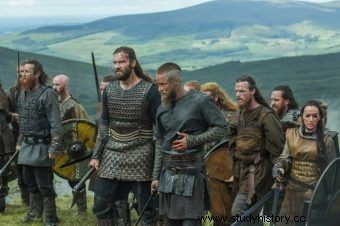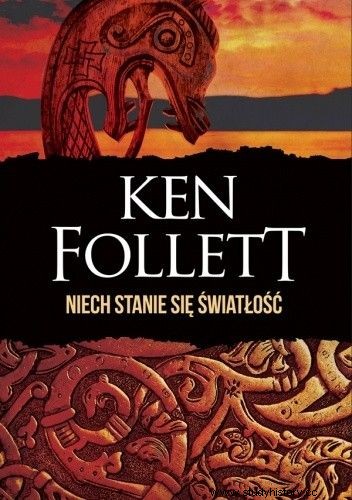There are many legends about the Vikings and they have survived to this day. Most talk about brutal raids, torture of enemies and the downright demonic qualities of invaders from the North. One thing is for sure:during their raids, you wouldn't want to live close to the coast ...
Another boat loomed in the distance, followed by a third and a fourth. The sails puffed in the rising southeast wind as the light boats glided over the waves. Edgar jumped to his feet.
The Vikings were thieves, rapists and murderers. They attacked along the coasts and up the rivers. They burned towns and villages, took whatever they could carry and slaughtered everyone except for the young men and women who were taken captives and sold into slavery. Edgar hesitated for a moment. He could see ten boats now, which meant at least five hundred Viking warriors were sailing towards them

The invaders from the North did not know holiness in the European sense - they plundered monasteries without hesitation.
This is how Ken Follett describes the view just before the raid in the novel Let There Be Light . But were the Vikings really - as the protagonist put it - "thieves, rapists and murderers"? It is difficult to generalize when looking at history in retrospect. Raid episodes did happen, of course, and their reasons can be found both in the simple desire to take away goods or slaves, or in ... starvation.
Exactly so - at times when the hometowns of the "peoples of the North" were abundant in food, the coastlines of the Islands and Europe could usually sleep peacefully and even enjoy the visits of distinctive boats. The Vikings could also trade, and in times of peace they were eager to look for buyers and sellers overseas.
Terror from beyond the great water
The Vikings might have owed much of their success on the warpath to their bad reputation. Grounds? Pretty prosaic. The invaders from the North did not know holiness in the European sense - they plundered monasteries without hesitation.
The most frequently cited example of such a situation, at the same time considered to be the beginning of the Viking Age in Britain, is of course the invasion of the Lindisfarne monastery in 793. The terrified clergy did not know what had hit them and immediately assigned the attackers a devilish face. The myth spread quickly, picked up by the gray inhabitants. It didn't take long for everyone to tremble at the mere thought of an attack.
The acrid odor of thatched roof hit his nose. The bitter southwest wind made the fire spread at an alarming rate. It was daytime. People ran out of the huts carrying babies, younger children, and whatever they had precious:tools, chickens, and leather pouches of money. The fastest ones were already running across the fields towards the forest. Seeing this, Edgar thought that thanks to the bell, at least some would be able to escape.
This is how Ken Follett, in his latest novel, Let There Be Light , imagines the moment when the people of British Combe realize the desperate situation they have found themselves in. There was no question of fighting…
An easy target
As raiders, the Vikings focused on poorly defended locations. Their attacks were lightning fast, aimed at collecting as much loot and slaves as possible. Then there was a retreat - before the defenders could organize. The pursuit of most fleets of that time might have forgotten:Viking ships were unsurpassed.
The visitors from the North fought lightly armed. They wore leather jackets or - later - chain mail. They carried swords, axes and spears in their hands, and sometimes used bows. As additional protection, some of the warriors carried the distinctive round shield and helmet. Occasionally they did a horse fight.

The article was inspired by the book by Ken Follett "Let there be light", which was published by the Albatros publishing house
It wasn't until the Eropeanans learned to repel the Vikings' attacks that larger battles began to take place. An example is, of course, the siege of Paris in 885–886, where - according to some historians - there were about 30,000 attackers! Nevertheless, the most dangerous and - it would seem - the most terrible were still the quick forays targeting vulnerable communities. This is what Ken Follett describes in his novel Let There Be Light :
A few brave inhabitants decided to fight back. Edgar didn't recognize them, because they had their backs to him. Some were armed with axes and daggers, one had a bow and arrows. For a moment Edgar stared at them, paralyzed by the sight of the sharp blades slashing the flesh, the animal screams of the wounded, the smell of the burning city. Until now, he had only watched fist fights between arguing boys or drunk men. It was something new:gushing blood, guts pouring out of ripped bellies, screams of fear and terror. He froze with horror.
Combe's traders and fishermen were no match for the invaders who lived off the murder. It only took a moment for the Vikings to slaughter the village's defenders and move on. More were following them.
Inspiration:
- Follett, K.. Albatros Publishing House, Warsaw, 2020.
Bibliography:
- Horspool, D., King Alfred:Burnt Cakes and Other Legends , Harvard University Press, 2006.
- R. Ferguson, Hammer and Cross. A new history of the Vikings . Dolnośląskie Publishing House, 2009.
- A. Forte, R. Oram, F. Pedersen, Viking States. Conquests - Power - Culture . Polish Scientific Publishers PWN, 2010.
- Parker, P., Northmen's Fury. The history of the Viking world. Rebis Publishing House, 2016.
